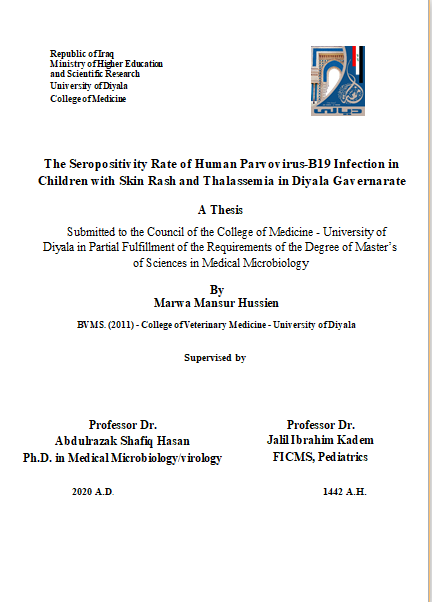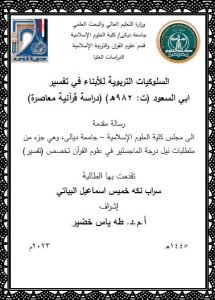summary
Human parvovirus B19 (parvo B19V) is the only member of Parvoviridae family, genus of Erythrovirus, pathogenic to humans. It is a non-enveloped, icosahedral virus containing single-stranded linear DNA genome. VP2 is the main capsid protein and forms 95% of the impact of the virus particle size. It is composed of two structural proteins, (VP1 and VP2) incorporated with VP1 proteins to make the capsid structure. This is graded as erythrovirus but has a distinct tropism for human erythroid progenitor cells and triggers apoptosis in compromised erythroid progenitors, contributing to acute and chronic anemia. Parvo B19V infection is common worldwide, transmited by respiratory droplets, contaminated blood products which is transplacentaly from an infected mother to the fetus. The most common clinical manifestation of parvo B19V during childhood is erythema infectiosum (Fifth disease or slapped cheek) which is mainly characterized by fever and rash, Arthralgia and arthritis particularly in adults.
The objectives of this study are to explore the prevalence of Parvo B19V IgG and IgM antibodies among children with fever and skin rash, and to figure out the Parvo B19V infection in children with thalassemia and to determine its ratio of association with socio-demographic factors.
This is across‑sectional study conducted in Diyala province from December 2019 to August 2020. The study population included children from AL-Batool Teaching Hospital for Maternity and Children, Baquba Teaching Hospital, Khanqin General Hospital, Jalawla General Hospital and Central Blood Bank.This study enrolled 395 participants. The following categories were grouped; 60 children apparently healthy as control; 200 children presented skin rash and fever as clinically suspected erythema infectiosum and 135 children with laboratory confirmed thalassemia. The age range was from 1 to 14 years. A questionnaire form was preconstructed for this purpose. ELISA Anti-HEV IgM and IgG (DIA-PRO, Italy) antibodies and titer were calculated. Human privacy was respected by obtaining the verbal consent of the parents of selected children. Statistical analysis was done via SPSS version 26 and P values less than 0.05 were considered significant.
It was found that anti-parvovirus B19 IgG rate of positive between children with clinically suspected erythema infectiosum was (95.0%), in the children with thalassemia, it was (89.6%), and among healthy children, it was (63.3%) a statistically insignificant difference (P= 0.062). The anti-parvovirus B19 IgM rate of positive among children with clinically suspected erythema infectiosum was (45.0%), in children with thalassemia it was (34.8%), while among healthy children it was (3.3%) a statistically insignificant difference (P= 0.063).
The Mean ± SD of anti-Parvovirus B19 IgG titer of children with clinically suspected erythema infectiosum, children with thalassemia and healthy children were 2.400 ±1.590 IU/L, 1.929 ±1.955 IU/ L and 1.434 ±1.220 IU/L respectively with high significance in clinically suspected children with erythema infectiosum (P= 0.0001). Whereas, the Mean ± SD of anti-Parvovirus B19 IgM titer of children with clinically suspected erythema infectiosum, children with thalassemia and healthy children were 0.722±0.541 IU/L, 0.621±0.449 IU/L and 0.294±0.267 IU/L respecrtively, with high significance in clinically suspected erythema infectiosum (P= 0.0001). However, there was insignificant correlation between other variables; age, residence, gender and clinical signs with Parvo B19V IgM titers and IgG titers.
The analysis found that the hemoglobin level was also presented insignificantly different among the study groups. In thalassemia patients there were a significantly lower values in the level of PCV (P=0.0001); mean corpuscular volume (MCV) (P=0.007); mean corpuscular hemoglobin (MCH) (P=0.0001). Therefore, thalassemia patients had significantly higher MCHC value (P=0.003) compared to other groups.
The result of the correlation of anti-parvovirus B19 IgG titer with different variables showed that the platelets count was significantly correlated with the anti-parvovirus B19 IgG titer in children with erythema infectiosum (r = 0.182, P= 0.010), but not in other groups. Other variables were insignificantly correlated with the IgG titer. The correlation between anti-parvovirus B19 IgM titer and other different variables such as the hemoglobin concentration, PCV%, WBC count in children with erythema infectiosum were significantly correlated with the anti-parvovirus B19 IgM titer ( r=-0.203, P= 0.004; r= -0.184, P= 0.009; r= 0.154, P= 0.030) respectively. Other variables in erythema infectiosum and other groups were insignificantly correlated with the Parvo B19V IgM titer.
In conclusion, the seroprevalence of parvo B19V as detected by anti-parvovirus B19 IgG among children in Diyala province was high. Asymptomatic infection among children was recorded (3.3%). Anti-parvovirus B19 IgM as a marker of recent infection was high among children with erythema infectiosum as well as thalassemia patients. The parvo B19V was associated with severe anaemia particularly among childrens with thalassemia, suggesting that in these risky children. This virus should be considered as an etiological agent.





